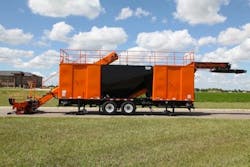Bergkamp Mobile Stockpile
Material transfer vehicle combined with a storage trailer describes the Mobile Stockpile, which eliminates the need for off-site stockpiles, says the manufacturer. Trucks bring aggregate and emulsion to the jobsite, load the Stockpile, and truck-mounted slurry seal or microsurfacing pavers connect to it. The machine is designed to use a minimal footprint, taking just one lane-width of roadway for an entire static stockpile operation. Aggregate is dumped into the inlet hopper located at the rear of the unit, and then transferred to the 21.5 cubic yard main hopper on an enclosed 32-inch conveyor at a speed of up to six tons per minute. The main hopper can either store the material or simultaneously transfer it during filling via a 24-inch discharge conveyor. The discharge conveyor moves the aggregate up a 28-degree angle before leveling out horizontally toward the discharge end to make a smooth aggregate transition to the slinger conveyor. The slinger conveyor extends and throws the material into the truck-mounted paver at a rate of three tons per minute, retracting and slowing down as the truck evenly fills up to avoid over filling or spilling of the aggregate. Asphalt emulsion is loaded from a tanker evenly into four separate tanks on the Mobile Stockpile that together hold 6,000 gallons of asphalt emulsion. The Mobile Stockpile weighs 40,650 pounds empty and 147,900 pounds when fully loaded.
